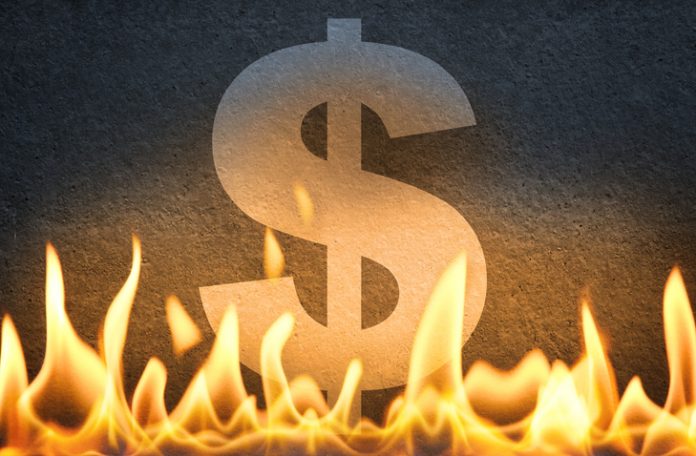Numbers don’t lie: Americans’ purchasing power down under Biden due to inflation, as wages lag behind. (Commentary)
During a recent interview with TIME magazine, President Biden said that during his time in office, “wage increases have exceeded the cost of inflation.” On its face, this is simply not true.
Since taking office in January 2021, the cumulative rate of inflation as measured by the Consumer Price Index, a figure calculated by the federal government’s Bureau of Labor Statistics (BLS), stands at 19.4 percent. On the other side of the equation, the increase in average weekly earnings, also calculated by BLS, stands at 14.1 percent. In other words, since Biden entered the Oval Office, real wages are down about 5 percent.
Such is why the number one concern among Americans heading into election season is the high cost of living. According to Gallup, the vast majority of likely voters cite the “economy in general” and the “high cost of living/inflation” as the “most important problem facing the country today.”
When it comes to the blame game, most Americans are pointing their finger at Biden for the poor economy overall and the persistent inflation that has made their lives appreciably worse over the past three-and-half years. Based on the most recent Real Clear Politics Poll Average, 57.6 percent of Americans disapprove of Biden’s handling of the economy.
For whatever reason, Americans’ anxiety about rising prices and stagnant wages is not registering with Biden. In the aforementioned TIME interview, Biden basically dismissed Americans’ valid concerns about inflation and how his policies have contributed to their struggles to make ends meet.
According to Biden, “corporate America [is] ripping off the public.” He also mentioned “shrinkflation” and “price gouging” as the main culprits behind the steep rise in prices for everyday and goods and services during his term.
In another recent interview, Biden downplayed Americans’ concerns about his economic stewardship, saying, “I think people are just uncertain, and that’s why we got to be steady, stay the course.”
This reminds me of Biden’s response to a question posed by CNN’s Erin Burnett in which he said with a straight face, “We’ve already turned it around … the polling data has been wrong all along.” Most Americans are “personally in good shape … they have the money to spend,” Biden added.
The reality is that in Biden’s America, most Americans are not in good economic shape and most Americans have no money to spend on anything but the bare necessities. According to a payroll.org survey, 78 percent of Americans are living paycheck to paycheck. Moreover, 29 percent of Americans “reported that their income doesn’t even cover their standard expenses,” per a Forbes Advisor poll also conducted in 2023.
Even worse, credit card delinquencies have risen every month of the Biden administration as more than 20 percent of Americans have “maxed out” their cards over the past three years. Americans are also struggling to pay their auto loans and more than 20 million households are unable to pay their utility bills on time.
I could cite a laundry list of other statistics detailing how much ordinary Americans are struggling to get by under Biden because it is plainly obvious that under Biden, most Americans are worse off than they were four years ago.
But, I’m going to go in a different direction and remind people that the exact opposite scenario occurred under President Trump. Before the COVID-19 pandemic upended the worldwide economy, President Trump’s pro-growth policies had ushered in an economic renaissance unseen in this country for decades.
The Wall Street Journal reported in 2019, “Wages for rank-and-file workers are rising at the quickest pace in more than a decade, even faster than for bosses.”
The Federal Reserve Bank of Atlanta’s Wage Tracker also showed that wage gains for the bottom quintile of workers rose faster than wage gains for the highest quintile throughout Trump’s first three years.
Even The New York Times admitted that “Black workers’ wages are finally rising” during the Trump era.
And, Per Reuters, “Income inequality in the United States narrowed in the first three years of the Trump administration as rising wages and a low unemployment rate fueled gains for lower-income and less educated families, according to U.S. Federal Reserve data.”
On the other hand, as Bloomberg reports, under Biden, U.S. income inequality has risen to an all-time high.
The evidence could not be clearer. During President Trump’s first term, before the pandemic, hardworking Americans were getting ahead. Inflation was low. Job growth was robust. There was a general sense of optimism.
Conversely, during President Biden’s first term, hardworking Americans are falling behind. Inflation has reached nearly 20 percent. Good-paying jobs are not being created. And, an overwhelming sense of pessimism and anxiety has gripped the country. The contrast could not be starker.
Chris Talgo is editorial director and a research fellow at The Heartland Institute.
Originally published by Townhall. Republished with permission.
For more Budget & Tax News.











